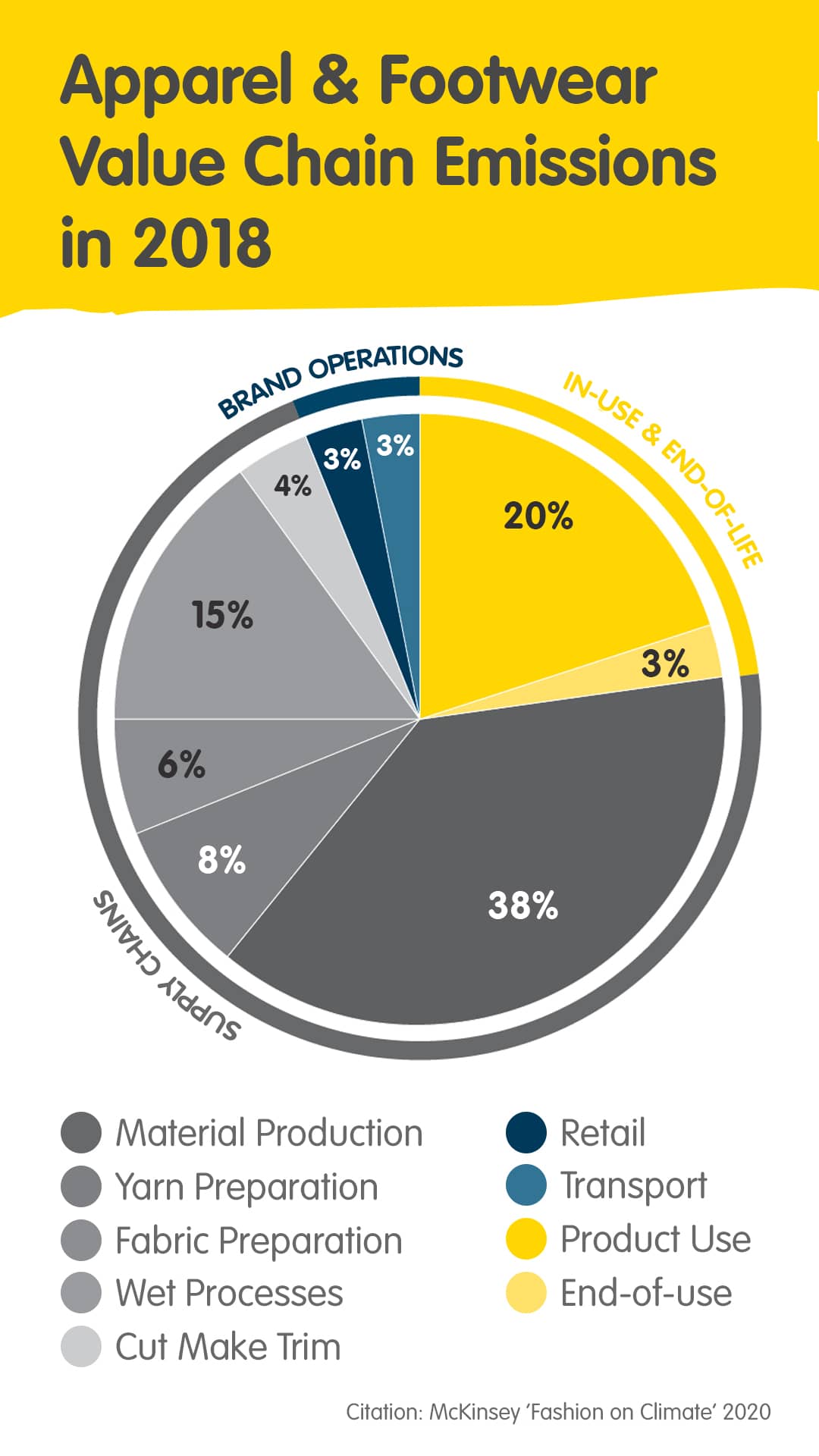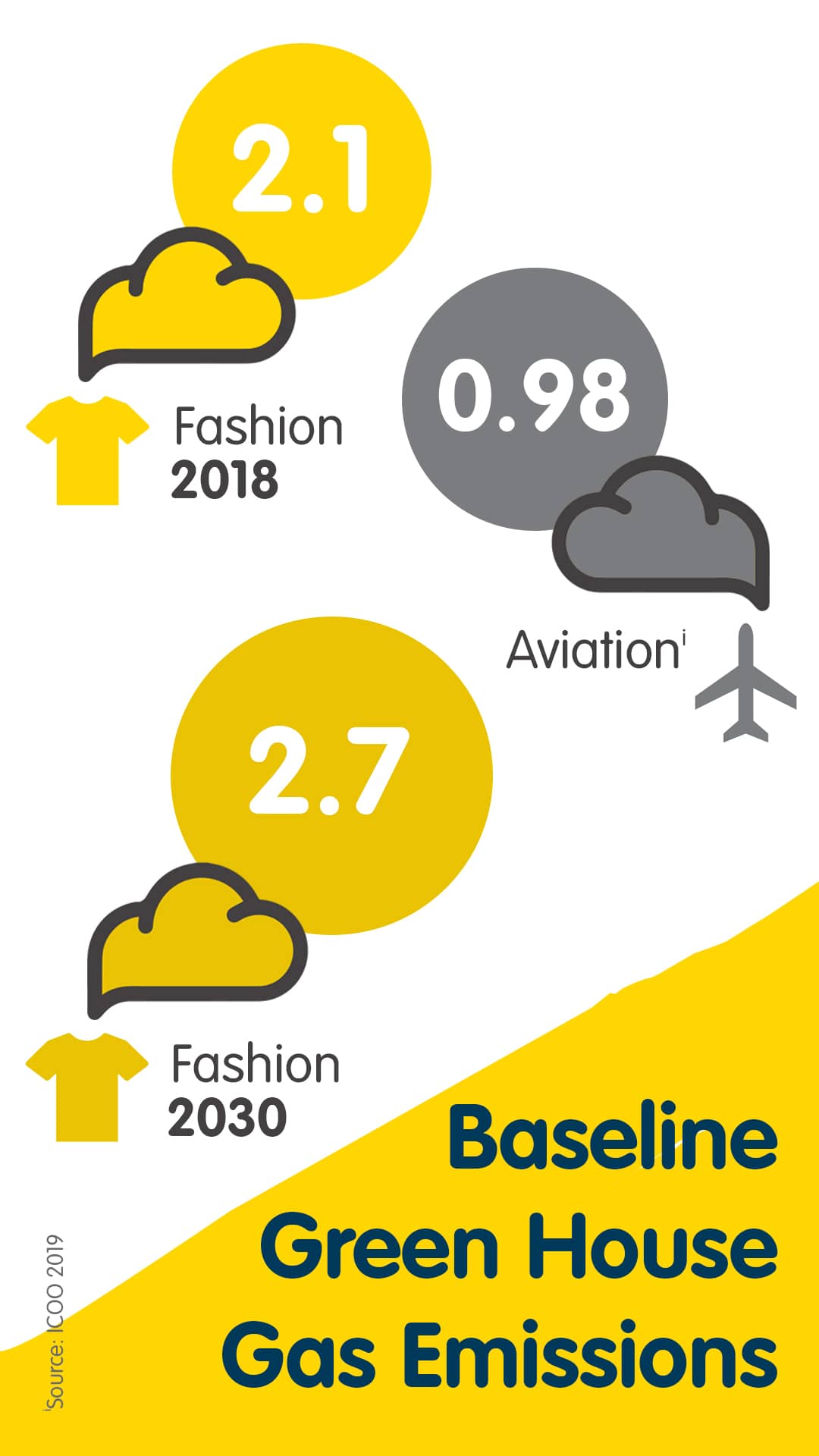When you ponder the biggest climate change contributors, what industries come to mind? Perhaps transport, energy, or maybe even the villainous mining?
Well, here’s a newsflash for you. The global fashion industry contributes up to 10 per cent of greenhouse gas (GHG) emissions. Yep, that’s right—our clothes and consumer appetite are a big contributor to climate change. Surprised?
It’s not just the manufacture of clothes that count here. In fact, emissions generated from the final production tier where your clothes are cut and sewn only accounts for four per cent of overall value chain emissions (including the lifecycle of a garment from raw fibre production through to consumer use and end-of-life). The biggest culprits are on the polar ends of the value chain—raw material production (growing/producing the fibre content) and consumer use (laundering).
Just these two phases account for almost 60 per cent of fashion’s 2.1 billion tonnes of annual GHG emissions. But here’s the scary thing: if no further action is taken beyond current measures, this figure is projected to reach 2.7 billion tonnes by 2030.


With the climate COP (Conference of Parties) happening in Glasgow this week, climate action is taking its rightful place in the world news – front and centre.
The United Nations Climate Change Conference & The Fashion Industry
If you’re not familiar with the COP, also known as the United Nations Climate Change Conference, it’s a meeting of global leaders from countries committed to climate action through the Paris Agreement. Achieving these global goals and averting the worst of climate change will require collaboration from all sectors—government, private business, and citizens.
The fashion industry has its own global organised climate pact called the Fashion Industry Charter for Climate Action and is part of the United Nations Framework Convention on Climate Change (UNFCCC). The charter aims to achieve net-zero emissions for the fashion industry by 2050, with an intermediary target of 30 per cent by 2030. Seventeen companies assessed in the Ethical Fashion Report are signatories to this commitment.
So, what are other fashion companies doing to reduce their impact on climate change? Unfortunately, not nearly enough.
What Are Fashion Companies Doing To Reduce Their Impact On Climate Change?
The just released 2021 Ethical Fashion Report uncovered that most companies are yet to take serious accountability for reducing supply chain emissions. Only 29 per cent of companies surveyed evidenced a public climate target and decarbonisation pathway (the measurable, timebound roadmap for a company to achieve its emissions reduction target) for their full supply chain.
When we break down the companies by location, it becomes an even more dire reflection on Australian companies in particular. Of the 25 companies that did evidence a comprehensive commitment and strategy, only four are Australian or New Zealander. This may speak to the comparatively smaller size of our local companies, with international players accessing deeper funds to finance emissions mapping and reduction schemes.
But why does any of this matter? Although climate change affects all of humanity, people living in low- and middle-income countries—where most of the world’s garment production takes place—face the greatest impacts. Rising sea levels, more frequent and severe natural disasters, and fresh water and food shortages could see more than one billion people displaced from their homes by 2050. Low- and middle-income countries are less likely to have sufficient infrastructure to address these ecological threats, or funding to prepare for and address disasters as they happen.
The world’s largest garment producing countries, such as China, Bangladesh, Vietnam, and Cambodia, are amongst the countries facing rising sea levels with projections showing large numbers of apparel factories could be underwater due to coastal flooding in coming decades.
How You Can Help Fashion Companies Make Change
If you’re passionate about climate action, ask companies if they’ve taken the following steps:
- Benchmarked current emissions to understand their starting point.
- Set a science-based emissions reduction target and decarbonisation pathway for their operations and supply chain. This should include the company’s operations, such as stores and offices, as well as third-party owned operations, such as factories.
- Signed onto a multi-stakeholder climate commitment, such as the Fashion Industry Charter on Climate Change.
- Communicated with consumers what action they’re taking to reach their targets and provide regular updates to hold themselves accountable.
Your Fashion Choices & Climate Change
If you’d like to put your personal convictions into action, here are a few things you can do:
- Choose to shop from companies with a climate target and de-carbonisation pathway. Baptist World Aid has done all the hard work for you to identify industry leading companies in our Ethical Fashion Report Appendix resource—check out the Report Appendix question 17.1 for top scorers.
- Let companies who haven’t published a climate target know that this is important to you, and you want to see them do better. Have you made a conscious decision to purchase more from brands taking climate action, or avoid those who haven’t? Let them know! Use our easy Speak Out to Brands tool to make contact today.
- Love your clothes longer. Take care of them, and launder less and only as needed. But the most important thing you can do is extending their wearable life before getting rid of them!
- When it’s time to get rid of old clothes, dispose of them consciously. If they’re no longer wearable, send them to a textile recycler to keep them out of landfill.
We all have a role to play—whether it’s advocating to companies and politicians about the action we want to see, or making conscious everyday choices to contribute to a lower-emissions future. Climate change waits for no one—so let’s get to it!

